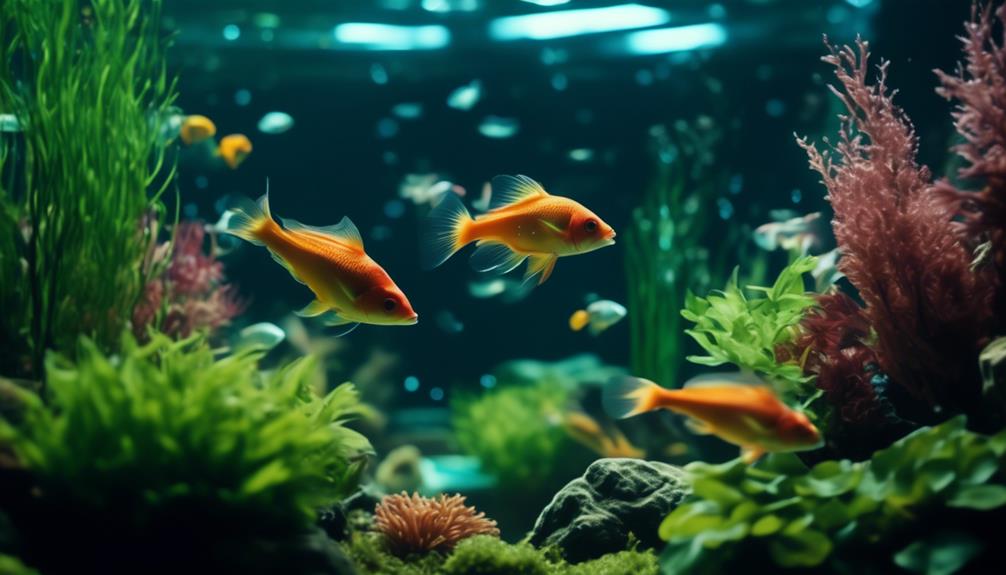The world beneath the water's surface holds a plethora of secrets waiting to be unveiled, and one such secret lies in the revolutionary power of carbon dioxide (CO2) in the aquatic realm.
While the significance of CO2 in planted aquariums is well-known, there is still much to be discovered about its intricate role in sustaining and optimizing aquatic life.
From its importance in photosynthesis and pH regulation to its impact on fish health and algae control, CO2 holds the key to unlocking the full potential of the aquatic world.
In this discussion, we will explore some of the groundbreaking secrets surrounding CO2 and its potential as a powerhouse in the aquatic ecosystem.
Key Takeaways
- Plants in planted aquariums require carbon for photosynthesis and can utilize naturally occurring CO2 from surface gas exchange and animal respiration.
- High tech aquariums use supplemental CO2 to provide an abundance of carbon for faster plant growth, along with proper lighting and fertilization.
- Dissolving CO2 in water forms carbonic acid, which lowers the pH. CO2 injection should be timed to run when lights are on to avoid a dramatic drop in pH during the tank's dark period.
- Excessive CO2 can be harmful to fish, but it can also help lower the pH for fish species that prefer slightly acidic water. Monitoring CO2 levels and ensuring proper aeration is important for fish health in a planted tank.
The Importance of CO2 in Aquatic Photosynthesis
Aquatic photosynthesis relies heavily on the presence of carbon dioxide (CO2) as a vital component for plant growth and the production of oxygen in planted aquariums. Plants require carbon for photosynthesis, a process where they convert CO2 into energy-rich molecules and release oxygen as a byproduct.
In low tech tanks, plants can utilize the naturally occurring 2-3 ppm of CO2 from surface gas exchange and animal respiration. However, in high tech aquariums, CO2 supplementation is necessary to maximize plant growth. By injecting CO2 into the water, along with proper lighting and fertilization, aquarium plants can thrive and grow at a faster rate. This supplementation provides an abundance of carbon, which is crucial for the plants' metabolic processes, resulting in lush and healthy growth.
Maximizing plant growth not only enhances the aesthetic appeal of the aquarium but also contributes to maintaining a balanced ecosystem.
Ph Regulation and CO2 in Planted Aquariums
The regulation of pH in planted aquariums is intricately linked to the presence of carbon dioxide (CO2) and is crucial for maintaining a stable and optimal environment for aquatic photosynthesis.
When CO2 is dissolved in water, it forms carbonic acid, which lowers the pH. In low-tech tanks, plants rely on the naturally occurring 2-3 ppm of CO2 from surface gas exchange and animal respiration.
However, high-tech aquariums use CO2 supplementation to provide an abundance of carbon for faster plant growth. It is important to time the CO2 injection to run when the lights are on, as plants consume CO2 and release oxygen during the day.
Injecting CO2 at night is inefficient and can lead to a dramatic drop in pH. Monitoring and maintaining pH stability through CO2 supplementation is essential for creating a healthy and thriving planted aquarium.
Ensuring Fish Health With Proper CO2 Levels

Maintaining appropriate levels of carbon dioxide (CO2) in a planted aquarium is crucial for ensuring the health and well-being of the fish inhabitants. While CO2 injection is beneficial for plant growth, it is important to implement CO2 safety measures to prevent CO2 toxicity.
Excessive CO2 can lead to fish gasping at the surface or suffocating. To alleviate excessive CO2, increased aeration with an air stone can be implemented. Additionally, using CO2 indicator or test kits can help monitor and assess CO2 levels, ensuring fish safety.
Proper monitoring of CO2 levels is essential for fish health in a planted tank. By implementing these measures, fish enthusiasts can create a thriving and balanced environment for their aquatic pets, promoting their overall health and longevity.
Controlling Algae Growth With CO2 Injection
Controlling algae growth in planted aquariums can be effectively achieved through the strategic implementation of CO2 injection. This technique maximizes plant growth by providing an abundant supply of carbon, which promotes the healthy development of aquatic plants.
Here are four CO2 dosing techniques that can help in controlling algae growth:
- Consistent CO2 Levels: Maintaining a stable CO2 concentration is vital to prevent fluctuations that can trigger algae outbreaks. A CO2 regulator and solenoid valve can help regulate the injection rate and ensure a constant supply of CO2.
- Adequate CO2 Distribution: Proper distribution of CO2 throughout the tank is important for uniform plant growth and to minimize dead spots. Diffusers, reactors, or atomizers can be used to ensure efficient CO2 diffusion.
- CO2 Monitoring: Regularly monitoring CO2 levels using drop checkers or electronic CO2 monitors is essential to ensure optimal levels for plant growth while avoiding excessive concentrations that can harm fish.
- CO2 Injection Timing: CO2 injection should be synchronized with the lighting period of the tank. This ensures that plants have access to CO2 during their photosynthetic activity, maximizing their ability to outcompete algae for nutrients and light.
Natural Entry of CO2 Into Water and Its Significance

To further explore the dynamics of CO2 in planted aquariums, it is important to understand the natural entry of CO2 into water and its significance for aquatic plant growth.
Aquatic plants in the trade originate from areas where water is naturally rich in CO2. Spring water, for example, can become saturated with CO2 at spring heads. Additionally, certain bodies of water with low pH and KH buffer allow CO2 to freely enter at a high rate.
Different plant species have adapted to grow in different CO2 concentrations, and some plants in the trade come from environments with unlimited access to atmospheric CO2.
Understanding the natural entry of CO2 into water is crucial because it helps us appreciate the benefits of CO2 supplementation and the factors that affect its availability to aquatic plants, ultimately promoting their growth and health in a planted aquarium.
Frequently Asked Questions
What Are the Benefits of Injecting CO2 Into a High-Tech Planted Aquarium?
Injecting CO2 into a high-tech planted aquarium offers several benefits. It helps balance pH levels by promoting the growth of aquatic plants, which consume CO2 and release oxygen. This process creates a healthier and more vibrant environment for both plants and fish.
How Can Excessive CO2 Affect Fish Health in a Planted Tank?
Excessive CO2 in planted tanks can negatively impact fish health. It can lead to fish gasping at the surface or suffocating. Monitoring CO2 levels, providing adequate aeration, and using CO2 indicator kits are crucial strategies to maintain optimal CO2 levels for fish in planted aquariums.
What Are Some Signs That Indicate the Need for Increased Aeration in a Planted Aquarium?
Increased aeration in a planted aquarium is necessary when signs such as fish gasping at the surface or suffocating are observed. Monitoring dissolved oxygen levels is crucial to ensure fish health and well-being in the tank.
Can CO2 Injection Alone Control Algae Growth in a Planted Aquarium?
CO2 injection alone may not fully control algae growth in a planted aquarium. While it promotes plant health and growth, implementing alternative algae control methods, such as balancing lighting, nutrient levels, and regular maintenance, is essential for effective algae management.
How Do Different Plant Species Adapt to Varying Levels of CO2 in Their Natural Environments?
Different plant species adapt to varying levels of CO2 in their natural environments through various strategies. They may have different mechanisms for CO2 uptake, such as specialized structures or enzymes, and they can adjust their metabolic processes to optimize carbon assimilation and growth.
Conclusion
In conclusion, the secrets of CO2 in the aquatic world have been unveiled, revealing its crucial role in:
- Photosynthesis
- pH regulation
- Fish health
- Algae control in planted aquariums
Proper monitoring and timing of CO2 injection are essential to maintain a thriving and balanced ecosystem. By understanding the natural entry of CO2 into water and its intricate relationship with aquarium life, aquarists can harness the full potential of CO2 as a powerhouse in the aquatic world.

